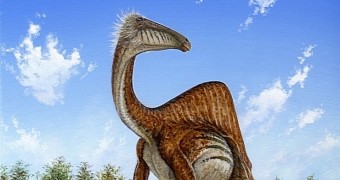A recent paper in the journal Nature describes an odd dinosaur that lived about 70 million years ago and that looked strikingly similar to Quasimodo, the Hunchback of Notre Dame.
The ancient creature, featured in the image next to this article, sported a rather impressive humpback. Besides, it had a pretty big belly and no teeth whatsoever.
Paleontologists say that it lived close to rivers and that it chiefly ate fish. Interestingly enough, evidence at hand indicates that this creature could grow to be about the size of a T. rex.
Not a newly discovered species
It is understood that researchers first documented the existence of this species about 50 years ago, when fossilized remains of such a dinosaur were unearthed in the Gobi Desert in southern Mongolia.
These remains comprised a set of forelimbs measuring as much as 2.4 meters (7.8 feet) in length, shoulder girdles, i.e. the bones that connect the upper limbs to the rest of the skeleton, and some rib and vertebra fragments, Nature informs.
Having analyzed these fossils, scientists concluded that they were dealing with a new species, which they named Deinocheirus mirificus. However, seeing how they didn't have all that much to work with, they failed to deliver an accurate description of the creature.
Not too long ago, the skeletal remains of two other Deinocheirus mirificus were found not far from the site that produced the fossils that served to identify this species as a self-standing one. Based on these newly found remains, researchers were able to gain a better understanding of these ancient beasts.
Introducing the wackiest dinosaur ever
As mentioned, these creatures had a freakishly big humpback and a fairly impressive abdominal region that paleontologists say can best be described as a beer-belly. In fact, the dinosaur's belly was so big that it needed special support.
Thus, scientists say that this long lost creature's anatomy included blade-like structures that projected out of its spinal vertebrae and that had a network of ligaments attached to them. It is these ligaments that paleontologists believe helped support the dinosaur's massive belly.
Then again, it's not like they had any gyms, plastic surgeons, or nutritionists growing up in the late Cretaceous Period, so nobody can really blame this fellow for evolving to live in harmony with its big belly rather than simply try to shake it off.
As surprising as this may sound, it appears that, despite the fact that they were in the business of hunting fish for a living, these dinosaurs had no teeth whatsoever. On the contrary, their skulls, which measured more than 1 meter (3.2 feet) in length, ended with a beak.
It is believed that, apart from fish and other aquatic creatures, these ancient beasts also ate plants growing at the bottoms of rivers and lakes. All things considered, they probably relied on a positively humongous tongue to reach the plants and pull them from the ground.
Judging by its anatomy, Deinocheirus mirificus most definitely wasn't built for speed. Paleontologists say that it probably spent most of its time just casually walking around, exploring river banks and shallow river beds.
Its big feet that ended with freakishly big toes whose tip was flattened made it possible for this creature to go about its business hunting fish and feasting on aquatic plants without fearing that it would sink in soft sediments deposited at the bottom of lakes and rivers.
Kind of, sort of related to T. rex
This dinosaur did not in the least look scary, fierce, or anything of the sorts. Truth be told, its appearance can only be described and downright goofy. Still, paleontologists say that this creature was a distant cousin of T. rex.
Specifically, they say that Deinocheirus mirificus belongs to a subgroup of theropod dinosaurs known to the scientific community as ornithomimosaurs, i.e. bird-mimicking lizards. Since T. rex was also a theropod, this means that, probably much to its shame, it was related to this odd creature.

 14 DAY TRIAL //
14 DAY TRIAL //